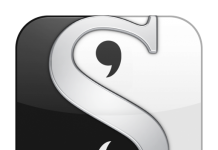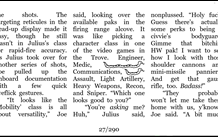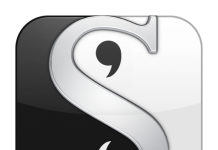 I’m delighted to present a first part of a tutorial on how to create epub ebooks, written by Paul Salvette. Formatting files for digital distribution might look difficult, but it’s good to give it a try – and Sigil seems to be the best tool available. What’s most important – Paul did a great job to explain it as simple as possible.
I’m delighted to present a first part of a tutorial on how to create epub ebooks, written by Paul Salvette. Formatting files for digital distribution might look difficult, but it’s good to give it a try – and Sigil seems to be the best tool available. What’s most important – Paul did a great job to explain it as simple as possible.
Today you’ll learn how to get started with Sigil. In the two next parts Paul will share tips on styling a document, adding images, metadata, table of contents, and finalizing the work. Don’t hesitate to check Paul’s exceptionally helpful book on how to format documents before you upload them to major self-publishing platforms. If you don’t want to miss next parts of the tutorial, get free updates of the blog.
Formatting an eBook can be a daunting task for the self-publisher who is not familiar with HTML. Many people try to upload a file (such as a .doc and .rtf) from their word processing program directly to the big eBook distributors only to find that the formatting is a complete mess and an embarrassment to the author. This is because eReading devices display eBooks similar to the way a web browser views a website, not how a word processor reads files.
For those interested in all the nitty-gritty details of proper eBook formatting, you can check out my guide How to Format Your eBook for Kindle, NOOK, Smashwords, and Everything Else for just $2.99 or my tutorial series for free. Understandably, many self-publishers do not have the patience or time to learn the HTML skills required to turn a manuscript in their word processor into a quality eBook. That’s where the free program Sigil comes in, which allows indie authors to craft an EPUB eBook with minimal technical knowledge.
What is EPUB?
The EPUB format is used by Barnes & Noble NOOK, the iBookstore, and numerous other eBook distributors and aggregators. As a matter of fact, it’s pretty much used by everyone except Amazon. It is an open standard format that compresses all of the images, content, and meta information into one .epub file that can be opened by a variety of eReaders and PC-based software like Adobe Digital Editions. Unfortunately, the construction of an EPUB file is complicated, difficult to validate, and uses web design standards that were phased out years ago. There is an EPUB tutorial on my website that isn’t much of fun read, and the official EPUB standard is available at the International Digital Publishing Forum, which can be a bit challenging for authors who are not technically inclined. Fortunately, Sigil helps take out a lot of the heavy lifting required to make a valid EPUB.
Getting started with a TXT file
Using Sigil allows you to avoid most of the technical stuff to get your eBook created in the EPUB format in a short amount of time. The program is available for Windows, Linux, and Mac users, and it doesn’t cost a dime. Once you download and install it, you’ll be ready to get started. Sigil can only open TXT, HTML, and EPUB files. Unless you enjoy torturing yourself, you probably did not write your novel in a text editor. One useful trick to convert your manuscript into a TXT file is to use the “Save As” feature in Microsoft Word, Open Office, or another word processor. The example below is from Microsoft Word 2007.

When asked about what type of encoding to use, make sure to select “UTF-8″. You will now have a TXT file that can be opened with programs like Notepad, Notepad++, and Sigil.
Starting up Sigil
Once you launch Sigil and open your TXT file, it will look similar to your manuscript, but all the text will be the same font, there will be no italics/bold/underlined text, and all your images will be gone. Here is an example of how it might look:

The main pane is the “What You See is What You Get” or WYSIWYG portion of Sigil, and this is how the text will actually look on an eReader. The far left pane is the Book Browser. This is the actual directory structure of your EPUB package that Sigil has generated for you. The “content.opf” file is the package that tells the eReading device exactly how the eBook is compiled and contains the metadata. The “toc.ncx” file is the meta Table of Contents. Unless you want to be advanced, it is advisable to not alter the content.opf or toc.ncx files directly. The meta Table of Contents should not be confused with a linked Table of Contents (sometimes referred to as a “traditional Table of Contents”) that you see in the content of some eBooks. Unfortunately, Sigil does not have a good way to generate internal hyperlinks required for a traditional Table of Contents.
If you click on the Split View function in the top menu, it will pull up the actual HTML of your eBook below the WYSIWYG pane.

You’ll notice that every paragraph of your eBook is wrapped in <p> and </p> tags, which is how a web browser or an eReader determines where a paragraph starts and where it ends. For individual lines of text, such as “Chapter X” headings and section breaks, they will should also be wrapped in <p> and </p> tags.

 Paul Salvette is an author who lives in Bangkok, Thailand, with his wife, Lisa, and newborn daughter, Monica. He grew up in the United States and served in the Navy from 2002 to 2009, with some time in Iraq. His day job involves working at a Thai foundation that focuses on poverty eradication, philanthropy, and education. He hopes to stay in Thailand until he is deported or dies of natural causes, whichever comes first.
Paul Salvette is an author who lives in Bangkok, Thailand, with his wife, Lisa, and newborn daughter, Monica. He grew up in the United States and served in the Navy from 2002 to 2009, with some time in Iraq. His day job involves working at a Thai foundation that focuses on poverty eradication, philanthropy, and education. He hopes to stay in Thailand until he is deported or dies of natural causes, whichever comes first.
Learn more about Paul at http://paulsalvette.com or follow him on Twitter @PaulSalvette.

































Paul, thankyou for this, and especially for the suggestion to use the UTF-8 (Unicode) character set. For readers of this article: Unicode handles all world languages and symbols. Even if you write exclusively in English and don’t use symbols, someone may get your permission to translate your writing, and will work from the same file. Please get into the habit of using UTF-8, because it makes internationalization much simpler. 🙂
I’m currently re-reading Agatha Christie, this time in ebook format. Harper Collins have done a sloppy job of formatting these ebooks, but the most annoying thing after the egregious typos and split or combined words, is the fact that Poirot’s occasional and very simple French phrases are ruined by the lack or mispositioning of accents. It’s hard to imagine how HarperCollins could make such a dog’s breakfast out of such a simple task, but using UTF-8 (and running some basic checks) would have done justice to Agatha’s work, where sloppy formatting keeps jolting me out of the story.